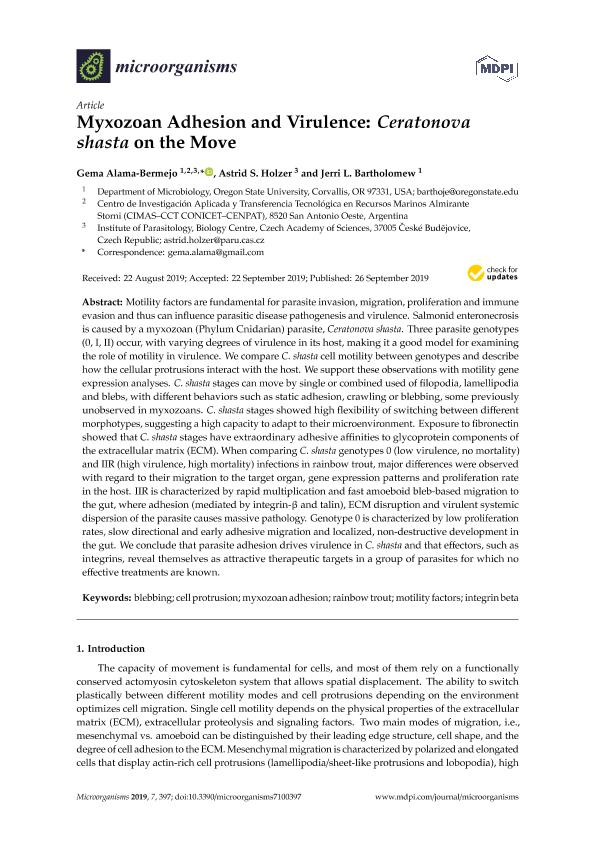Mostrar el registro sencillo del ítem
dc.contributor.author
Alama Bermejo, Gema

dc.contributor.author
Holzer, Astrid Sybylle

dc.contributor.author
Bartholomew, Jerri

dc.date.available
2020-11-06T20:50:35Z
dc.date.issued
2019-09
dc.identifier.citation
Alama Bermejo, Gema; Holzer, Astrid Sybylle; Bartholomew, Jerri; Myxozoan Adhesion and Virulence: Ceratonova shasta on the Move; MDPI; Microorganisms; 7; 10; 9-2019
dc.identifier.uri
http://hdl.handle.net/11336/117853
dc.description.abstract
Motility factors are fundamental for parasite invasion, migration, proliferation and immune evasion and thus can influence parasitic disease pathogenesis and virulence. Salmonid enteronecrosis is caused by a myxozoan (Phylum Cnidarian) parasite, Ceratonova shasta. Three parasite genotypes (0, I, II) occur, with varying degrees of virulence in its host, making it a good model for examining the role of motility in virulence. We compare C. shasta cell motility between genotypes and describe how the cellular protrusions interact with the host. We support these observations with motility gene expression analyses. C. shasta stages can move by single or combined used of filopodia, lamellipodia and blebs, with different behaviors such as static adhesion, crawling or blebbing, some previously unobserved in myxozoans. C. shasta stages showed high flexibility of switching between different morphotypes, suggesting a high capacity to adapt to their microenvironment. Exposure to fibronectin showed that C. shasta stages have extraordinary adhesive affinities to glycoprotein components of the extracellular matrix (ECM). When comparing C. shasta genotypes 0 (low virulence, no mortality) and IIR (high virulence, high mortality) infections in rainbow trout, major differences were observed with regard to their migration to the target organ, gene expression patterns and proliferation rate in the host. IIR is characterized by rapid multiplication and fast amoeboid bleb-based migration to the gut, where adhesion (mediated by integrin-β and talin), ECM disruption and virulent systemic dispersion of the parasite causes massive pathology. Genotype 0 is characterized by low proliferation rates, slow directional and early adhesive migration and localized, non-destructive development in the gut. We conclude that parasite adhesion drives virulence in C. shasta and that effectors, such as integrins, reveal themselves as attractive therapeutic targets in a group of parasites for which no effective treatments are known.
dc.format
application/pdf
dc.language.iso
eng
dc.publisher
MDPI
dc.rights
info:eu-repo/semantics/openAccess
dc.rights.uri
https://creativecommons.org/licenses/by/2.5/ar/
dc.subject
BLEBBING
dc.subject
CELL PROTRUSION
dc.subject
MYXOZOAN ADHESION
dc.subject
RAINBOW TROUT
dc.subject
MOTILITY FACTORS
dc.subject
INTEGRIN BETA
dc.subject.classification
Genética y Herencia

dc.subject.classification
Ciencias Biológicas

dc.subject.classification
CIENCIAS NATURALES Y EXACTAS

dc.title
Myxozoan Adhesion and Virulence: Ceratonova shasta on the Move
dc.type
info:eu-repo/semantics/article
dc.type
info:ar-repo/semantics/artículo
dc.type
info:eu-repo/semantics/publishedVersion
dc.date.updated
2020-07-20T19:27:37Z
dc.identifier.eissn
2076-2607
dc.journal.volume
7
dc.journal.number
10
dc.journal.pais
Suiza

dc.conicet.avisoEditorial
This article is an open access article distributed under the terms and conditions of the Creative Commons Attribution (CC BY) license (http://creativecommons.org/licenses/by/4.0/).
dc.description.fil
Fil: Alama Bermejo, Gema. Academy of Sciences of the Czech Republic. Biology Centre. Institute of Parasitology; República Checa. Oregon State University; Estados Unidos. Universidad Nacional del Comahue. Centro de Investigación Aplicada y Transferencia Tecnológica en Recursos Marinos "Almirante Storni". - Provincia de Río Negro. Ministerio de Agricultura, Ganadería y Pesca. Centro de Investigación Aplicada y Transferencia Tecnológica en Recursos Marinos "Almirante Storni". Consejo Nacional de Investigaciones Científicas y Técnicas. Centro Científico Tecnológico Conicet Centro Nacional Patagónico. Centro de Investigación Aplicada y Transferencia Tecnológica en Recursos Marinos "Almirante Storni"; Argentina
dc.description.fil
Fil: Holzer, Astrid Sybylle. Academy of Sciences of the Czech Republic. Biology Centre. Institute of Parasitology; República Checa
dc.description.fil
Fil: Bartholomew, Jerri. Oregon State University; Estados Unidos
dc.journal.title
Microorganisms
dc.relation.alternativeid
info:eu-repo/semantics/altIdentifier/url/https://www.mdpi.com/2076-2607/7/10/397
dc.relation.alternativeid
info:eu-repo/semantics/altIdentifier/doi/http://dx.doi.org/10.3390/microorganisms7100397
Archivos asociados
